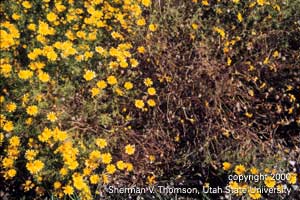Verticillium Wilt
 Characteristic field appearance of a Verticillium infection. Normally Verticillium will affect a single plant (foci) and radiate out.
Characteristic field appearance of a Verticillium infection. Normally Verticillium will affect a single plant (foci) and radiate out.
 Wilt symptoms of a Geranium plant infected with Verticillium. One stem shows a greater degree of infection than the others. In Geranium and some other flowering plants there may not be any visible vascular discoloration.
Wilt symptoms of a Geranium plant infected with Verticillium. One stem shows a greater degree of infection than the others. In Geranium and some other flowering plants there may not be any visible vascular discoloration.
Verticillium wilt, caused by the fungus Verticillium albo-atrum, is a disease of many vegetable and fruit crops as well as ornamentals, affecting over 300 plant species. The soil-borne fungus enters the plant through the roots and spreads systemically throughout the water conducting vessels. This results in partial or complete plugging of the vascular system, causing wilting and eventually death of the plant.
SYMPTOMS
Symptoms of Verticillium wilt are most likely to show up when the weather turns warm after a cool period. The foliage of the affected plant turns yellow and wilts, drying up progressively from the base to the top of the plant. If the stem is cut open, a brown discoloration in the vascular system (water conducting tissue) can be observed. The roots are generally not rotted, and usually no cankers or discolorations are visible on the outside of the stem.
CONTROL MEASURES
Since Verticillium albo-atrum is present in many soils, most control measures are based on preventing infections. Use resistant varieties when possible if a Verticillium wilt problem has been encountered in previous seasons. Keep plants healthy and vigorous with proper fertilization and irrigation, especially during periods of hot weather. Avoid planting in old vegetable gardens or berry patches, because the fungus is probably present in such soil. Always remove and destroy any infected plants.
In important beds, the Verticillium fungus can be controlled by fumigation with Benlate 50 WP, this fumigant can only be purchased and applied by a certified applicator. Before applying Benlate, always thoroughly cultivate the area to be treated, breaking up clods and loosening the soil deeply. This cultivation should be completed one week before application, and the soil should be kept moist, by watering if necessary. Success depends on how carefully the soil is prepared before application. If the soil is crusted immediately before application, cultivate lightly.

